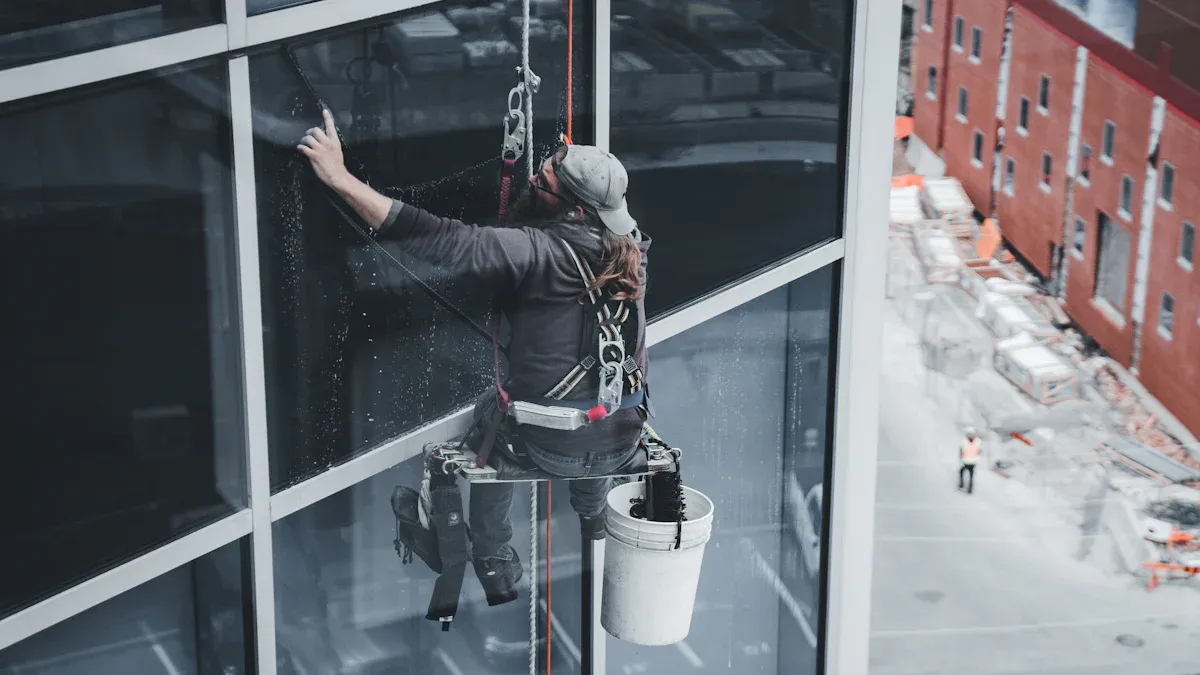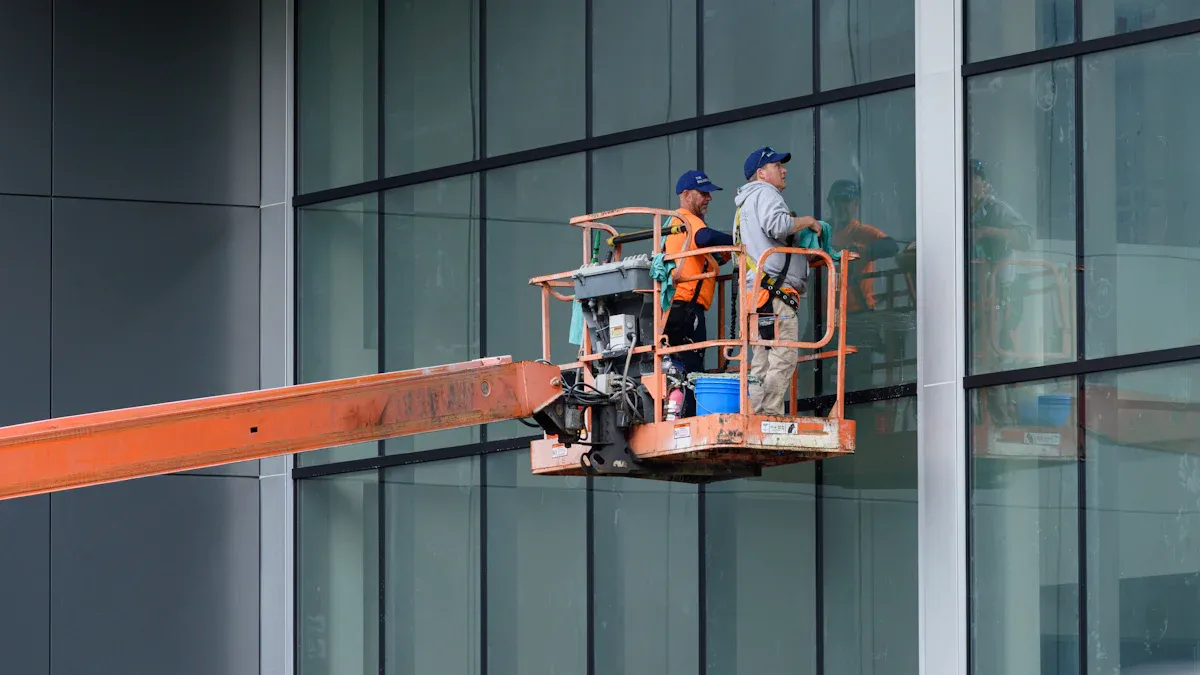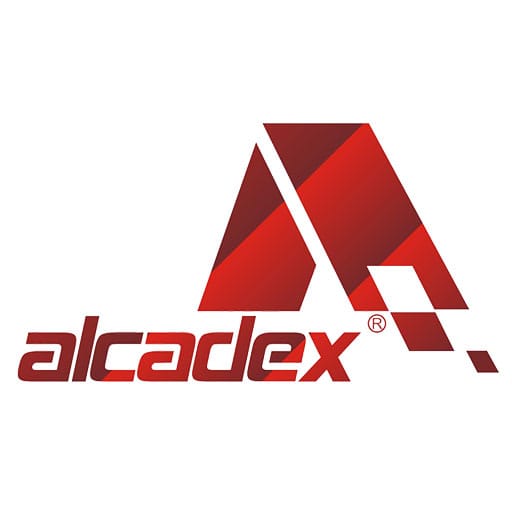
30 Aug A Complete Guide to Curtain Wall Maintenance in 2025
Table of Contents
You take care of curtain wall systems best in 2025 by doing regular checks, cleaning, and fixing problems fast. Taking care of them often keeps your building looking nice and working right. Research shows that keeping curtain walls in good shape can save you a lot of money each year, help save energy, and make your building last longer.
Aspect | Description | Impact |
|---|---|---|
Heat loss reduction | Upgrading to high-efficiency systems (U-value 0.29) | |
Annual cost savings | Improved thermal performance in cold climates | $18,500/year saved |
Lifecycle savings | Energy bill reductions over 30 years | $550,000 saved |
Advanced technology | Thermal barriers and vacuum insulated glazing | 50-65% higher efficiency |
Cleaning and checking curtain walls often helps you find leaks, broken seals, and rust early. This keeps your building using less energy and protects your building’s value.
Key Takeaways
Check your curtain wall every six months. Look for leaks, cracks, and damage early. This helps stop big problems before they start.
Clean the glass and aluminum frames two times a year. Use mild soap and soft tools. This keeps your building looking nice and helps it last longer.
Fix small leaks and broken seals right away. This saves money and stops water damage or energy loss.
Call experts for big repairs or if you see cracked glass, rust, or loose panels. This keeps your building safe.
Doing regular maintenance saves energy and lowers costs. It also helps your curtain wall system last longer.
Curtain Wall Basics

System Overview
Curtain wall systems are on lots of new buildings. They cover the outside but do not hold up the building. These systems hang from the main structure and block wind and rain. There are a few main types of curtain wall systems:
Stick System: Workers put together mullions and panels at the building site. This type is good for special shapes and small buildings.
Unitized System: Factories make big panels that are ready to use. This saves time and helps make sure the quality is good, especially for tall buildings.
Semi-Unitized System: This type uses some factory-made parts and some parts built on-site. It is fast and can be changed if needed.
Pressure-Equalized System: These are made to keep out water and air. They work well in places with strong wind or lots of rain.
Key Materials
Most curtain wall frames are made from aluminum. Aluminum is light, strong, and does not rust. Sometimes, builders use steel or wood for special jobs. Glass is the most common panel material. Glass lets in sunlight and helps save energy. Some designs use stone, plastic, or composite materials too.
Material | Role in Curtain Wall Construction | Key Properties and Benefits |
|---|---|---|
Glass | Infill panel material | Transparency, energy efficiency, aesthetic appeal, safety |
Predominant framing material | Lightweight, strong, corrosion-resistant, versatile | |
Steel | Used in specific projects | High strength, durability |
Wood | Used in hybrid systems | Natural look, combined with aluminum for strength |
Combines glass, metal, insulating layers | Better thermal performance, sound insulation | |
Stone | Used in luxury applications | Durable, luxury appearance |
Why Maintenance Matters
Taking care of your curtain wall keeps your building safe and nice. If you do not check and clean it often, problems can happen quickly. Water might leak inside, panels could get loose, and metal might rust. Sometimes, broken glass or falling pieces can be dangerous. Regular care stops these things before they get worse. It also helps your building use less energy and saves money on fixing things.
Tip: Make a plan for checking and cleaning. Doing things early stops big problems later.
Maintenance Steps

Inspection Routine
You need to inspect your curtain wall system often to keep it safe and working well. Start by looking at the wall from a distance. Use binoculars to spot cracks, drip marks, or loose joints. Move closer to check any areas that look suspicious. Look for these signs of trouble:
Shrinking or missing window gaskets.
Cracks and erosion in mortar joints.
Blistered or peeling paint.
Rust stains, especially near steel fasteners.
If you see any of these problems, you should act quickly. These signs can lead to water getting inside, air leaks, or even safety hazards. Most experts recommend checking your curtain wall every six months. In busy or high-risk places, you should inspect every three months.
Tip: Keep a checklist for each inspection. Write down what you find and what you fix. This helps you track changes and plan repairs.
Curtain Wall Cleaning
Cleaning your curtain wall keeps it looking good and helps it last longer. Use mild soap or gentle detergent with a soft cloth, sponge, or brush for aluminum frames. For glass panels, use neutral soap or slightly acidic cleaners to remove dirt and water stains. If you find tough stains or grease, you can use solvents like xylene or alcohol, but be careful not to damage the sealants.
Never use strong acids, strong alkaline cleaners, or abrasive tools like steel wool. These can scratch the surface, cause microcracks, and damage protective coatings. High-pressure washing above 1500 psi can peel off finishes and expose metal to rust. Always use non-abrasive tools and neutral cleaners.
Surface | Recommended Cleaner | Tools to Use | Avoid |
|---|---|---|---|
Aluminum Frame | Mild soap or detergent | Soft cloth, sponge | Abrasive pads, strong acids |
Glass Panel | Neutral soap, gentle solvent | Dust-free cloth | Strong solvents, rough brushes |
Note: Clean your curtain wall at least twice a year. If your building is near a busy road or the ocean, you may need to clean more often.
Preventative Programs
Many manufacturers offer preventative maintenance programs for curtain wall systems. These programs help you catch problems early and keep your building safe. Here is what you can expect:
Routine testing every six months, or every three months in busy areas.
Keeping drop zones clear to meet safety codes.
Regular visual checks for fabric wear or dust buildup.
Detailed logs for inspections, repairs, and part replacements.
Service by factory-certified technicians using original parts.
Modern programs use digital inspection tools, IoT sensors, and drone images. These tools help you spot issues before they get worse. Many companies now use eco-friendly cleaners and sealants to protect the environment. You also get support for special building needs and help with new safety codes.
Tip: Join a manufacturer’s maintenance program if you want expert help and better records. This can save you money and keep your curtain wall working well for years.
Common Issues
Leak Detection
You may notice leaks in your building when water appears near windows or frames. Leaks often start small but can cause big problems if you ignore them. Many leaks happen because of missing or poorly applied sealants, faulty flashings, or clogged weep holes. Sometimes, condensation builds up inside the wall because of poor ventilation or missing vapor barriers.
Internal joints with poor sealant work or missing drainage holes let water collect and leak.
Perimeter gaskets and spandrel panels can fail if installers miss steps or if gaskets wear out.
Operable windows and vents may leak when gaskets do not fit well or hardware is not adjusted.
You can use several methods to find leaks. Acoustic imaging uses sound to spot leaks in real time. This tool helps you find air leaks that often match water entry points. You can also use water spray tests, like the AAMA 501.2 hose test. This test sprays water at joints and seals to see if water gets inside. For more detailed checks, field tests like ASTM E1105 use a spray rack and air pressure to show where water enters.
Test Method | Description | Best Use Case |
|---|---|---|
Acoustic Imaging | Uses sound to find leaks in real time. | Pinpointing air and water leaks in complex areas. |
AAMA 501.2 | Sprays water at joints to check for leaks. | Quick field checks and troubleshooting. |
ASTM E1105 | Uses air pressure and water spray to test for leaks. | Detailed field testing of installed systems. |
Tip: Check for leaks after heavy rain or strong winds. Early detection helps you avoid costly repairs.
Seal and Panel Repair
Seals and panels keep your building safe from water and air. Over time, seals can crack, shrink, or fall out. Panels may get damaged by weather, impact, or age. You should inspect seals and panels often to catch problems early.
Look for cracks, gaps, or missing sealant around joints.
Patch small tears in panels with repair tape that matches the color.
Replace torn or worn panels right away.
Check that all trolleys and roller tracks stay attached and work smoothly.
Replace missing or damaged bottom sweep panels to keep zones sealed.
You should avoid using lubricants on roller trolleys. Lubricants attract dust and dirt, which can make the system work poorly. When you need to replace panels, plan the work carefully. Good planning helps you stay safe, control costs, and avoid disrupting building use. Work with experts who use the right tools and follow safety rules.
Note: Always use manufacturer-recommended parts and repair methods for the best results.
Surface Damage
Surface damage can affect both the look and function of your curtain wall. Moisture damage is the most common problem. Water can get inside and cause finishes to peel, mold to grow, and air quality to drop. Condensation on glass or aluminum happens when temperature and humidity change quickly.
Glass panels may crack because of nickel sulfide inclusions or sudden temperature changes. Storms can send debris flying, which can chip or break glass. Sometimes, mistakes during design or installation cause sealants to fail, letting water in.
Moisture damage: Water stains, peeling finishes, mold growth.
Glass damage: Cracks from temperature changes, impact, or material flaws.
Sealant breakdown: Gaps or missing sealant from poor application or age.
You should fix surface damage as soon as you see it. Quick action keeps your building safe and looking good.
Callout: Regular cleaning and inspections help you spot surface damage early and prevent bigger issues.
Professional Help
When to Call Experts
Call a professional if you see big problems with your curtain wall. Some problems are too hard to fix by yourself. You need an expert to keep your building safe and looking nice. Watch out for these signs:
Paint peeling off metal frames. This can cause rust.
Stains or marks on glass from pollution or strong cleaners.
Frames that bend or look out of shape.
Water drops inside the glass. This means the glazing is broken.
Tiny cracks in glass panels.
Rust on metal parts.
Leaks or broken sealants near windows and doors.
Glass that looks cloudy or has changed color.
Panels that are cracked, breaking apart, or coming apart in layers.
Parts of the outside wall that have moved out of place.
If you see any of these signs, call for help soon. Waiting can make the problem worse and cost more to fix. Getting help early can stop leaks, big damage, and expensive repairs.
If you wait too long to call experts, things can get worse. Water might get inside and cause mold or rust. Parts that do not fit right let in air and water. This makes your building use more energy. If you wait, you might have to replace big parts of the curtain wall. That costs much more than fixing small problems early.
Choosing Contractors
It is important to pick the right contractor for repairs. You want someone who knows how to work on curtain walls. Look for these things:
Qualification Aspect | Requirement Details |
|---|---|
Experience | |
Education | Degree in Architecture or Engineering |
Technical Skills | Advanced AutoCAD, BIM, and office software skills |
Project Management | Experience leading complex projects and managing teams |
Communication Skills | Strong client and team communication |
Legal Status | Licensed, insured, and authorized to work in the US |
Ask these questions before you hire anyone:
Can you give me names of past clients?
Will you show me a list of all costs?
How long will the project take?
Do you give a warranty for your work?
Tip: Pick a contractor who knows new fire and energy rules. Make sure they use safe materials and follow the newest standards.
A good contractor will tell you how repairs will go. They will answer your questions and keep you updated. You should expect clear answers, safe work, and repairs that last a long time.
You can keep your building safe by having a simple plan. Check your curtain wall often and clean it to stop big problems. Fix things fast so repairs do not cost a lot. This also keeps people inside safe. Here is a checklist you can use:
Wash glass and frames with soft, gentle tools.
Look at sealants, gaskets, and panels for any damage.
Fix problems right away so everything works well.
Always think about safety and making your building last. This helps protect your money and keeps your building working well for a long time.
FAQ
How often should you inspect your curtain wall?
You should inspect your curtain wall every six months. In busy or harsh environments, check every three months. Regular inspections help you find problems early and keep your building safe.
What cleaning products work best for curtain walls?
Use mild soap or gentle detergent with a soft cloth. Avoid strong acids, harsh chemicals, or abrasive tools. These can damage glass and aluminum surfaces.
Can you repair small leaks yourself?
You can fix small leaks by applying new sealant or replacing worn gaskets. For bigger leaks or if you feel unsure, call a professional. Safety comes first.
What signs show you need professional help?
Look for these warning signs:
Cracked or cloudy glass
Rust on frames
Water stains inside
Loose panels
If you see any of these, contact an expert right away.


